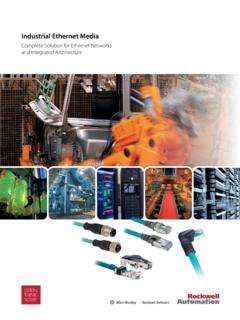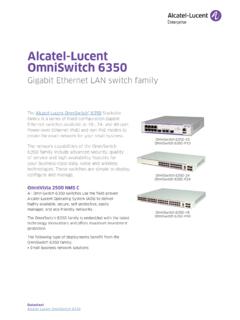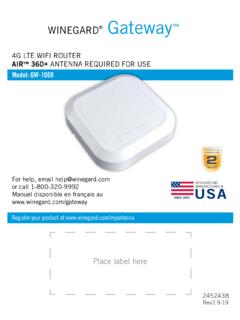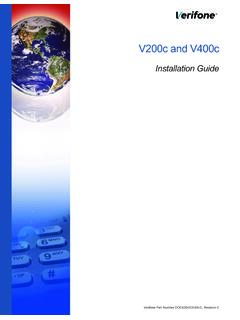Transcription of Selecting Cables for Power over Ethernet - Hitachi Cable
1 Hitachi Cable America Inc. Selecting Cables for Power over Ethernet Factors to Consider when Selecting the Appropriate Cable 8/120/2017. Hitachi Cable America, 900 Holt Avenue, Manchester, NH 03109. Power over Ethernet Standards and applications Increased energy efficiency has become a common consideration when developing just about any new electrical product. These technologies include lighting systems, access control, security systems with cameras, computers, access points for wireless networks and more. Where dozens, hundreds or even thousands of powered devices are active at a company site, reducing energy consumption (saving money) is typically a priority.
2 Power over Ethernet (PoE) allows devices to be powered over 4 pair category Cables . Such Cables are increasingly being installed to provide Power and control to devices requiring up to 100 watts of Power . Though it is extremely cost effective to utilize Category Cables for powering devices, there are a number of factors that must be considered to ensure the Cables will effectively and safely accommodate the type of PoE being utilized. Type 1 and Type 2 PoE. The first two types of PoE were established in the standards IEEE and IEEE The Power sourcing equipment compliant to these standards deliver 15 watts and 30 watts of Power respectively.
3 Typical applications would be for lower Power devices such as IP telephones, wireless access points and some cameras. Type 3 and Type 4 PoE. The IEEE committee is currently developing the standards for higher levels of PoE Power delivery. It is anticipated that Type 3 Power will offer up to 60 watts of Power , while Type 4 will deliver up to 100 watts. Type 4 PoE creates almost 20x the heat within the Cable compared to Type 1 PoE, and managing this heat generation is a key industry concern. See Chart 1. A critical point being addressed by the industry is that only some Cable constructions will be able to safely support a higher Power load in all installation configurations, specifically, Cable bundles of various sizes.
4 Some Cables may be appropriate for small bundles, but not for larger ones. Power Dissipated in Cable vs PoE Type 80. Almost 20x Heat generation Ratio of Power Dissipated vs for Type 4 compared to 60. Type 1 PoE. Type 1. 40. 20. 0. Type 1 Type2 Type 3 Type 4. Chart 1. Hitachi Cable America, 900 Holt Avenue, Manchester, NH 03109. Page 2 of 7. PoE Cable Safety Standards The 2017 NEC Now Includes PoE. The National Fire Prevention Association (NFPA) has now adopted important new sections for the 2017 NFPA 70. National Electrical Code (NEC), which include category Cable ampacity tables.
5 The proposed Ampacity table, a portion of which is shown below, will reside in section 725 and 800 of the NEC. The table clearly shows that that not all Cables can support the higher Power PoE types in all installation configurations. Number of 4-Pair Cables in a Bundle 1 2-7 8-19 20-37 38-61 62-91 92-192. Temp Rating Temp Rating Temp Rating Temp Rating Temp Rating Temp Rating Temp Rating AWG 60 C 75 C 90 C 60 C 75 C 90 C 60 C 75 C 90 C 60 C 75 C 90 C 60 C 75 C 90 C 60 C 75 C 90 C 60 C 75 C 90 C. 24 23 22 The table utilize specific Cable characteristics, including conductor gauge and temperature rating, to establish a safe Power rating (Ampacity) for the Cable .
6 For example, a Cable with 23 AWG conductors and rated for 75 C, can accommodate .6 Amps in a bundle up to 193 Cables . The anticipated 2017 NEC also includes a provision for a limited Power rating, or LP rating, which UL has developed as a standardized test to provide an alternate ampacity rating for specific Cable designs. This LP . rating is acknowledged in the NEC and can be used as an alternative to the values in the NEC ampacity tables. The ultimate goal of these efforts is to ensure that Cable designs optimized for PoE can be properly identified regarding how much Power they can safely handle.
7 Factors when Selecting Cables for PoE. Four key parameters for each Cable type and application determine Conductor the ability of a Cable to support PoE applications. See Figure 1. Each Size one of these characteristics is important to ensure safe PoE. operation. Just as important as choosing the correct Cable type, is choosing a Cable known to be of high quality and high reliability. With the amount of delivered Power increasing, great care should be UTP vs PoE Temp. Shielded Capacity Rating given to picking the right Cable , and by extension, the right Cable manufacturer.
8 PoE capability is highly affected by substandard Cables such as Installation counterfeit Cable with aluminum conductors or mislabeled Cables . Type Mitigating those risks by choosing Cables from a highly regarded manufacturer and one that is known to stand behind their products Figure 1. is highly recommended. Hitachi Cable America, 900 Holt Avenue, Manchester, NH 03109. Page 3 of 7. PoE Capacity and Heat Generation Even small changes in one of these four parameters can affect the overall temperature rise in PoE. applications. Image 1 on the right taken by a thermal camera in the Hitachi lab shows the temperature of 6.
9 Different Cables carrying identical currents. The image clearly demonstrates the significant differences in temperature rise among different Cable designs. It is obvious that the higher category Cables with the larger conductors bring additional Power load capabilities. Image 1. Conductor Gauge Size Conductor resistance (DCR) in PoE applications drives the amount of heat generated in the Cable . The larger conductor sizes in Category 6, 6A and 7A reduce the DC resistance, and thus the Power lost (lost in the form of generated heat) within the Cable itself.
10 A typical change in conductor resistance across category Cables is shown below in Chart 2. Every one percent reduction in conductor resistance results in the same ratio of reduction of dissipated Power in the Cable . Category 6 Cables tend to have about 80% of the DCR of Category 5e, thus only about 80% of the heat generation. Typical Heating Effect Cat 5e vs Category 6 Conductor (Lower is better) Size 110. Heating Effect Percent 100. UTP vs PoE Temp. 90 Shielded Capacity Rating 80. 70. 60 Installation Type Cat 5e Cat 6. Chart 2. Hitachi Cable America, 900 Holt Avenue, Manchester, NH 03109.









